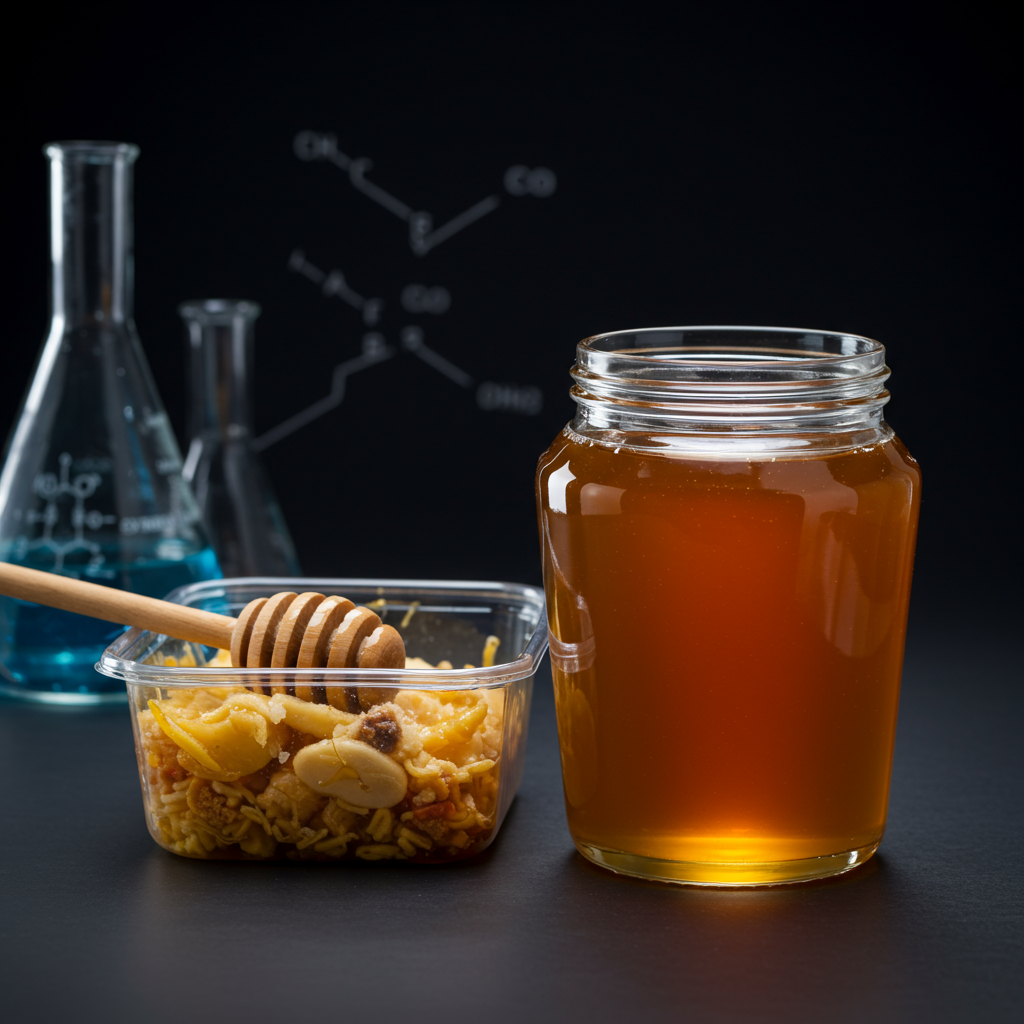Have you ever wondered why a jar of honey seems to last forever in your pantry? Most sweet, sugary foods are a prime target for hungry bacteria and mold, quickly turning into a fuzzy, unpleasant mess. Yet, pure honey stands apart, defying the usual rules of food spoilage. This remarkable resistance isn’t magic; it’s the result of a fascinating natural process engineered by honeybees and a unique chemical composition.
Understanding honey’s incredible shelf life starts with knowing what causes other foods to spoil. Microscopic organisms like bacteria, fungi, and molds are everywhere. They are the primary culprits behind decay. These tiny creatures thrive in specific conditions, needing moisture, moderate temperatures, a relatively neutral pH level, and often, plenty of oxygen to grow and multiply.
The Science of Spoilage: What Makes Food Go Bad?
When we say food has “gone bad,” we usually mean these microorganisms have started to consume it. They break down the food’s components, changing its texture, smell, and appearance. Often, these changes produce waste products that are unappetlyzing or even harmful.
Humans have developed various methods to prevent this microbial takeover. Dehydrating foods like jerky or dried fruit removes the essential water microbes need. Cooking at high temperatures kills many existing organisms, and refrigeration slows down the growth of any survivors. Pickling uses high acidity (low pH) to create an environment hostile to most bacteria. Sealing food in airtight containers limits oxygen access for aerobic organisms.
Despite these efforts, most preserved foods still have a limited shelf life. Over time, even in less-than-ideal conditions for microbes, some may eventually take hold. So, how does honey manage to avoid this common fate, often remaining edible for years, sometimes even millennia, when stored correctly?
How Honeybees Engineer an Unspoiled Food
Honey begins its life as flower nectar. Nectar is a sweet, watery liquid, typically containing around 70% to 80% water. On its own, this warm, sugary fluid would be an ideal breeding ground for bacteria and yeast. However, honeybees perform a remarkable transformation process that converts this perishable liquid into the stable, golden substance we know as honey.
The process starts when worker bees collect nectar and carry it back to the hive in their honey stomachs. During transport and within the hive, they begin to process the nectar. The bees add enzymes from glands in their mouths, notably an enzyme called invertase. Invertase plays a crucial role by breaking down the complex sugar sucrose (table sugar) found in nectar into simpler sugars: glucose and fructose. This enzymatic action also helps to slightly increase the acidity of the fluid, beginning to lower the pH.
Next, the bees deposit the partially processed nectar into the wax cells of the honeycomb. At this stage, the liquid still has a high water content. To reduce the water further, the bees perform an incredible feat of natural dehydration. They vigorously fan their wings over the open honeycomb cells. This constant fanning creates air currents that promote evaporation, much like wind drying clothes on a line.
This fanning process continues until the liquid’s water content is drastically reduced. Fully ripened honey typically contains only about 15% to 18% water. This figure is critically low.
The Powerful Barriers: Why Microbes Can’t Survive in Honey
The combination of extremely low water content and very high sugar concentration creates a state known to food scientists as “low water activity.” Water activity is not just the percentage of water but how much of that water is available for microorganisms to use for growth. In honey, the vast amount of sugar molecules tightly bind to the available water molecules.
This binding makes the water inaccessible to bacteria and fungi. Essentially, any microbial cells that land in honey become dehydrated. Water is drawn out of their cells by the surrounding sugar solution through osmosis, effectively killing or rendering them dormant. Even though honey is packed with sugar – a food source microbes would normally relish – they cannot access or metabolize it without sufficient available water.
Furthermore, the acidity of honey, which typically has a pH between 3 and 4.5, acts as another barrier. Most spoilage bacteria prefer environments closer to neutral pH levels and struggle to grow in such an acidic setting. While some acid-tolerant yeasts could theoretically survive, the low water activity usually inhibits them as well.
Finally, when honey is stored in a sealed container, the lack of readily available oxygen adds a third layer of defense against aerobic (oxygen-requiring) microorganisms. These combined factors – extremely low water activity, high acidity, and limited oxygen in storage – create an exceptionally hostile environment for the microbes that cause spoilage in most other foods.
Does Honey Ever Go Bad? Understanding Nuances
While honey is famous for its longevity, it’s important to clarify what “doesn’t spoil” means. Pure honey stored in a sealed, airtight container is microbiologically stable. It won’t grow harmful bacteria or mold that make it unsafe to eat in the way that dairy or meat would spoil. This is why archaeologists have reportedly found edible honey in ancient tombs.
However, honey can undergo physical changes over time. Crystallization, where the liquid honey turns thick and grainy, is a natural process resulting from glucose separating from the solution. It doesn’t mean the honey is spoiled or unsafe; the crystals can easily be re-dissolved by gently warming the honey.
The primary way honey’s natural preservation can be compromised is by improper storage or handling. Once a jar is opened, the honey is exposed to the air, which can introduce moisture and various microorganisms. Dipping wet or used spoons into the jar can also add water and bacteria. While honey’s inherent properties still offer resistance, repeated exposure can eventually lead to fermentation by wild yeasts, particularly if moisture is introduced. This controlled fermentation process, often initiated by adding water and specific yeasts, is precisely how mead, an alcoholic beverage, is made.
So, while honey isn’t literally “immortal,” its natural chemistry, perfected by the industrious work of honeybees, grants it an unparalleled resistance to microbial spoilage compared to almost any other natural food. Stored correctly, it remains safe and delicious for an exceptionally long time.
Frequently Asked Questions
What are the main reasons pure honey doesn’t spoil easily?
The primary reasons pure honey resists spoilage are its very low water content (resulting in low water activity), its natural acidity (low pH), and the high concentration of sugars. Honeybees reduce the water in nectar to just 15-18%, binding water molecules to sugars and making them unavailable for microbial growth. This dehydrates or inactivates bacteria and fungi. The acidic pH also creates an unfavorable environment for most spoilage organisms.
Does honey ever expire or become unsafe to eat?
When stored properly in a sealed container, pure honey is considered one of the only foods that does not microbiologically spoil. It won’t develop harmful bacteria or mold. Any expiration dates on commercial honey typically refer to quality, not safety. Over time, honey may crystallize or change color and aroma, but it remains safe to consume. Spoilage risks increase only if significant moisture or contaminants are introduced after opening.
How should I store honey to keep it fresh for the longest time?
To maximize honey’s natural shelf life, store it in a tightly sealed, airtight container. Glass jars with secure lids are ideal. Keep the container in a cool, dry place, such as a pantry, away from direct sunlight and sources of heat. Avoid storing it in the refrigerator, as this can accelerate crystallization. Always use a clean, dry spoon when scooping honey to prevent introducing moisture or contaminants.
In summary, the unique chemistry of honey – its low water activity, high acidity, and high sugar concentration, all products of the honeybees’ labor – creates an environment so inhospitable that the microorganisms responsible for spoilage simply cannot survive or thrive. It’s a natural masterpiece of preservation, allowing this sweet treasure to endure long after most other foods would have succumbed to decay.




